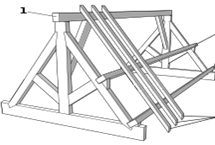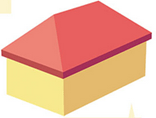This set of Civil Engineering Drawing Multiple Choice Questions & Answers (MCQs) focuses on “Madras Terraced and Sloping Roof”.
1. For the calculation of roof estimates start with a simple roof diagram, marking all pitch changes, valleys, ridge and hip lines, chimneys, vent pipes and other penetrations.
a) False
b) True
View Answer
Explanation: Then measure all exterior wall sections from corner to corner, adding in any roof overhangs or bump-outs. Put these dimensions in their place on the diagram.
2. Roof slope is typically defined in inches.
a) True
b) False
View Answer
Explanation: Roof slope, which is typically defined in inches. Some customers will know the roof slope and can supply it to you, but determining the slope yourself is easy. Unless there is a low-hanging roof eave, you may have to get on a ladder and work with a 1- or 2-foot level.
3. Pitch is defined as vertical rise (in inches) per foot of horizontal run.
a) True
b) False
View Answer
Explanation: Slope defined as vertical rise (in inches) per foot of horizontal run. For example, A roof that rises 6 inches for every 12 inches of run is a “six-in-twelve,” or 6:12 roof, with a pitch of ¼.
4. Simple gable roofs like those found on colonial or ranch homes are easy to calculate.
a) False
b) True
View Answer
Explanation: Simply take the ground dimensions, multiply length times width (include overhangs) and multiply by the roof pitch multiplier. For example, a 24 x 48 home with a 6:12 roof would calculate as follows: 24 x 48 = 1,152 x 1.12 = 1,290.24, or just over 1,290 square feet of roof.
5. Timber can be used as a sloping roof.
a) True
b) False
View Answer
Explanation: A timber roof truss is a structural framework of timbers designed to bridge the space above a room and to provide support for a roof. Trusses usually occur at regular intervals, linked by longitudinal timbers such as purlins. The space between each truss is known as a bay.
Timber roof trusses were a medieval development. Earlier roofs had been supported by coupled rafters – pairs of rafters linked by horizontal beams. But such roofs were structurally weak, and lacking any longitudinal support were prone to racking, a collapse resulting from horizontal movement.
Roof made with timber

6. _______ Terrace Roof is a flat roof consisting of a layer of lime concrete over a layer of brick-on-edge laid in lime mortar.
a) Sloping
b) Madras
c) Flat
d) Arch
View Answer
Explanation: The terrace bricks of 15*7.5*2.5cm in size are laid on-edge in diagonal rows with lime mortar 1:11/2 proportion closely packed spanning over the beams. The brickwork is then cured by sprinkling with water for a period of 10 days. After the brickwork has set, a layer of lime concrete is laid and consolidated so as to give a compact thickness of 7.5cm and cured for 6 days.
7. The figure shown below is an example of which type of roof?

a) Butterfly roof
b) Flat roof
c) Hipped roof
d) Gambrel roof
View Answer
Explanation: A hip roof, hip-roof or hipped roof, is a type of roof where all sides slope downwards to the walls, usually with a fairly gentle slope (although a tented roof by definition is a hipped roof with steeply pitched slopes rising to a peak).
8. The four-sided slopes are not the characteristic feature of only Mansard roofs the _______________ also come with this feature.
a) mansard roof
b) gambrel Roof
c) salt Box Roof
d) pyramid roof
View Answer
Explanation: The four-sided slopes are not the characteristic feature of only Mansard roofs; the Pyramid roofs also come with this feature. As the name suggests, these roofs are shaped like pyramids, a roof with four sloping sides. These roofs are best-suited for smaller structures, like a farmhouse hut. These roofs are popular in the contemporary architecture, with many structures getting these roofs. The walls of these houses are symmetrical and easy to build. A lower degree pitch works best for such four-sided roofs. They would work even better if the walls were smaller and the roof made for a significant part of the house. It is not only aesthetically pleasing, but also more energy efficient.
Sanfoundry Global Education & Learning Series – Civil Engineering Drawing.
To practice all areas of Civil Engineering Drawing, here is complete set of 1000+ Multiple Choice Questions and Answers.
If you find a mistake in question / option / answer, kindly take a screenshot and email to [email protected]
- Check Civil Engineering Drawing Books
- Apply for Civil Engineering Internship
- Practice Civil Engineering MCQs
- Check Civil Engineering Books
